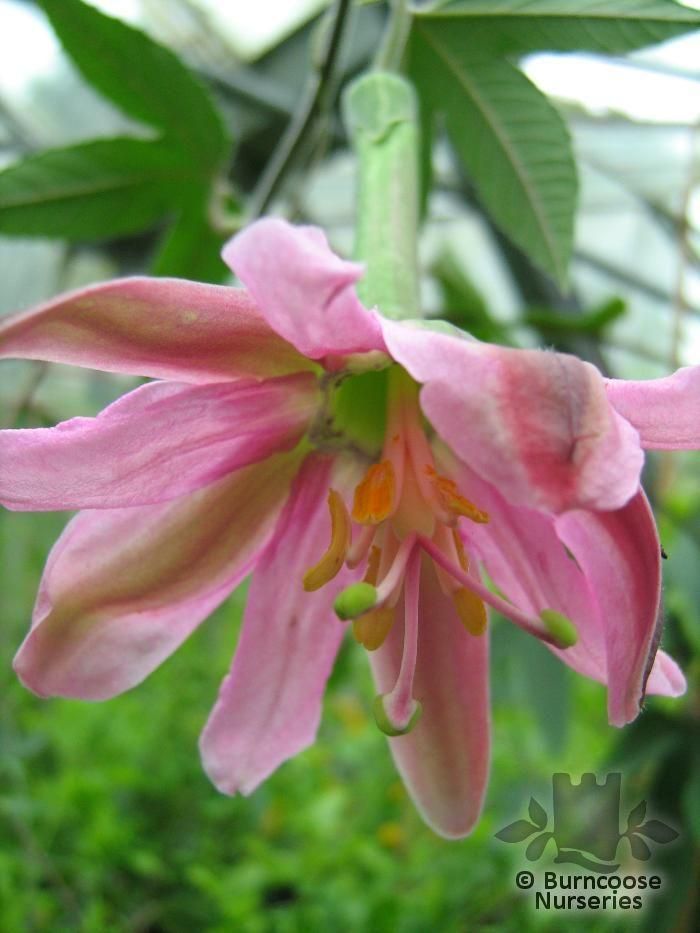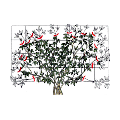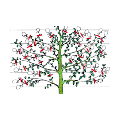Plants by mail order since 1984, over 4100 plants online today
Nursery & Gardens open: Mon - Sat 8:30 - 17:00 & Sun 10:00 - 16:00
Pop up café: open weather dependent
- Shop Now
- Burncoose Specialities
- This Month
- Offers & Promotions
- RHS Chelsea Flower Show 2024
- 40 years at Burncoose
- Engage With Us
- Information, Help & Advice
- About Us & Our Services
- Terms & Conditions
- Log In / Register

PASSIFLORA mollissima
Commonly known as Banana passion flower
Pendent long pale pink tubular flowers in late summer
Further Reading....
-
EvergreenMid-green leaves 10cm (4in) long with heart-shaped bases and 3 broad-toothed lobes.
-
 Shades of pinkAll shades of pink through to Carmine (red)Pink to coral-pink
Shades of pinkAll shades of pink through to Carmine (red)Pink to coral-pink -
 Height5m (16ft) or more
Height5m (16ft) or more -
ClimberSome of these climbing plants will need trellis or wire supports if grown on walls or fences. Other grow aerial roots and are self-clingingFast-growing tendril climber with moderately branching, slender, downy stems.
-
Zero Rated ItemNo VAT on this plant
-
 Heated greenhouse - warm temperateCan be grown outside in summer. Plant can withstand temperatures down to 5°C (41°F)
Heated greenhouse - warm temperateCan be grown outside in summer. Plant can withstand temperatures down to 5°C (41°F) -
 Full sun
Full sun -
 Partial shade
Partial shade
PASSIFLORA mollissima
-
Additional Features
 Good to knowoblong-ovoid flavoursome yellow fruit to 8cm (3in) long
Good to knowoblong-ovoid flavoursome yellow fruit to 8cm (3in) long Pests & DiseasesRed spider mites, whiteflies, mealybugs, scale insects, cucumber mosaic virus under glass
Pests & DiseasesRed spider mites, whiteflies, mealybugs, scale insects, cucumber mosaic virus under glass Place of originNorthern South America. Introduced by Cornish plant hunter William Lobb in the mid 1800s.Resistant to honey fungusThese plants have little or few problems with honey fungus.
Place of originNorthern South America. Introduced by Cornish plant hunter William Lobb in the mid 1800s.Resistant to honey fungusThese plants have little or few problems with honey fungus. -
Flower ShapeBowl-shapedPendent, long-tubed, 6-9cm (2½-3½in) across
-
Garden Location/ConditionsGreenhouse / conservatoryNot the sort of plants to be grown outside where there are likely to be frosts. These plants need to be grown in a conservatory or cool greenhouse or at least brought inside for the winter
-
HardinessTender (greenhouse & conservatory)
-
Pruning group
 Pruning group 6Suitable for: Evergreen shrubs or climbers that need little to no pruning.
Pruning group 6Suitable for: Evergreen shrubs or climbers that need little to no pruning.
Action: Trim back shoots that spoil symmetry and to fit available space.
When: Annually after flowering if on previous year's growth, or in later Winter or Spring if flowering on current year's growth, or as requires.
 Pruning group 8Suitable for: Wall trained shrubs and less vigorous climbers.
Pruning group 8Suitable for: Wall trained shrubs and less vigorous climbers.
Action: For climbers 'spur prune' by cutting back 3-4 buds of the permanent framework. For wall trained shrubs cut back flowered shoots to within 2-4 buds of permanent framework.
When: Annually after flowers if on previous year's growth, or in late Winter or Spring if on current year's growth.
-
Seasonal InterestAutumnSummer
-
Soil ConditionsFertile moist well-drained soilModerately fertile
Jan
Feb
Mar
Apr
May
Jun
Jul
Aug
Sep
Oct
Nov
Dec
Passiflora - Care Guide
Useful extras...

Fertilisers & Feeds - Vitax
Q4 Pelleted Fertiliser
A useful fertiliser suitable for use on a wide variety of plants. Q4 provides all the nutrients and trace elements essential for vigorous growth, abundant flowering and ripening of fruit.
3 options from £6.00

Fertilisers & Feeds - Empathy
Afterplant - Grow Your Own
AFTER PLANT GROW YOUR OWN seaweed is ready to use liquid concentrate that was specially formulated be used on all edible plants.
Only £8.00

Fertilisers & Feeds - Empathy
Afterplant - Tomatoes
AFTER PLANT TOMATO FEED Liquid Concentrate with Bio stimulant is a high potash liquid concentrate containing seaweed extract, plant derived amino acids and other nutrients specifically formulated to benefit tomatoes and greenhouse plants.
Only £8.00

Fertilisers & Feeds - Empathy
Rootgrow mycorrhizal fungi
Recommended by the RHS. Contains Rootgrow™ mycorrhizal fungi. Suitable for all trees and shrubs (except rhododendrons, azaleas, heathers, cranberries and blueberries)
3 options from £3.00

Fertilisers & Feeds - Empathy
Rootgrow Ericoid mycorrhizal fungi
This specially adapted Rootgrow™ mycorrhizal fungi will boost the growth of acid-loving plants like rhododendrons, azaleas, heathers and blueberries.
It contains ericoid and arbuscular mycorrhizal fungi, which are found in poor acidic soils where ericaceous plants naturally grow.
Only £7.50

Fertilisers & Feeds - Empathy
All-purpose Seaweed Stimulant
All-purpose organic concentrated seaweed feed that is a ready to use, derived from sustainable harvested kelp, that can be used on all outdoor and indoor plants, except acid loving plants.
Perfect used in conjunction with Rootgrow™.
Only £7.50

















